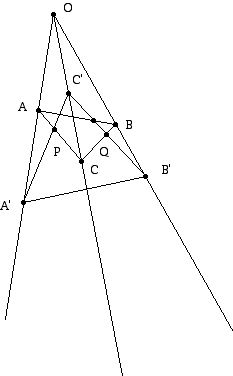
Geometric Structures: Session XI
Geometric Insights from Algebra
Prepared by:
Joseph Malkevitch
Department of Mathematics
York College (CUNY)
Jamaica, New York 11451
email:
malkevitch@york.cuny.edu
web page:
http://york.cuny.edu/~malk
The key to constructing finite affine planes and finite projective planes is initially via algebra. Since there are finite arithmetics with n numbers for all values of n which are a power of a prime, there are also finite affine planes with n2 points where n is the power of a prime. The "trick" is to imitate the way Descartes developed the Euclidean plane by using ordered pairs of real numbers to represent the points. Instead of using ordered pairs of real numbers, which form the kind of algebraic structure known as a field, we can use ordered pairs of numbers from a finite field. (Remember one property of real numbers that is not shared by the finite fields is that there is no way to order the numbers in a finite field so they will obey the same properties of order that the real numbers obey.)
An important result from real projective geometry known as Desargues Theorem plays a very important role here. Desargues was an French mathematician and engineer who lived from 1591-1661. His famous theorem is illustrated by the diagram below. The theorem states that if we have two triangles, ABC and A'B'C' with the property that the lines AA', BB', and CC' go through a single point O (that is the lines are concurrent) then the corresponding sides of the triangles meet at points which lie on a line. Thus, below, the line PQ passes through the point where AB and A'B' meet!

Desargues's theorem holds in the real projective plane but there are many projective planes in which it does not hold. These projective planes can be either infinite or finite planes. However, the finite projective planes which we constructed using finite arithmetics obey Desargues's Theorem. It turns out that when Desargues's Theorem holds it forces any coordinate system for the plane in which it holds to obey the associative law. The fact that the nature of the coordinate system for a projective plane which obey particular "configuration theorems" such as Pappus's Theorem and Desargues's Theorem determines the algebraic nature of coordinates for such planes is both amazing and intriguing. Pappus's Theorem is related to whether or not the coordinates obey the commutative law for multiplication. Wedderburn's Theorem (named for Joseph Wedderburn, 1882-1948) says that a finite division ring must be a field. (A division ring is an algebraic structure with two binary operations which obeys all of the field axioms except for commutativity.) So if a finite projective plane obeys Desargues Theorem it must also obey Pappus's Theorem! (An example of an infinite number system which is associative but not commutative is the quarternions. The quarternions originally developed by the Irish mathematician William Rowan Hamilton have three elements, usually denoted by i, j, and k, whose squares are -1. They also obey the additional rule that ijk = -1)
A few more comments about finite fields. In order to get a finite field with more elements from a smaller one we used a polynomial with coefficients in the integers mod p (p a prime) which had no root in the smaller field. Strictly speaking, one needs the even stronger condition that one can not factor this polynomial using coefficients in the integers mod p. Such polynomials are known as irreducible. (For the real numbers we know there are such irreducible polynomials of all positive integer degrees larger than 2.) It turns out that there is a similar result for the integers mod p (p prime). We can construct irreducible polynomials of any degree larger than 2. Often one can find many of these irreducible polynomials with the same degree. Will the fields one gets by adjoining a root of the different irreducible polynomials be different from each other? The remarkable fact is is that all finite fields with the same number of elements are isomorphic. Thus, very different looking representations, arising by adjoining roots of different irreducible polynomials of the same degree, are isomorphic. Another remarkable fact about finite fields is that they are cyclic. This means, that given any finite field, one can find a non-zero element of the field with the property that the powers (from 1 to (p-1)) of this element are all distinct. For example, for the integers mod 5, 3, 4, 2, 1, the powers of 3 up to 4 are all distinct from each other. Finite fields play a very central role in many aspects of mathematics. Among their many applications outside of mathematics is that they can be used to construct error correction codes. These codes make our cell phones, HDTV sets, and images from the Hubble Telescope possible.
We will see that the key to error correction codes is the idea of Hamming Distance, which is named for the American mathematician Richard Hamming. Given two strings of the same length, the number of positions that the strings differ in is called the Hamming Distance. Example: 1101 and 1001 differ only in the second position so they have Hamming distance 1, while 1001 and 0110 differ in all 4 positions so they have Hamming distance 4. The Hamming distance obeys all of the rules of distance that Euclidean distance or taxicab distance obey, including the triangle inequality. If we can assign objects strings (code words) whose Hamming distance is far apart we can correct errors that might occur in the strings. If one sends a string which is part of an error correcting code and the received string is not a code word, then one typically corrects the received string to that code word which is closest to the received string. If there are note too many errors made between the sent word and the received string, the errors can be corrected.